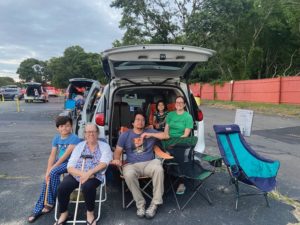WELLFLEET — On summer evenings before dusk, the parade of cars begins. Minivans, pick-up trucks, Volkswagen buses, and sedans inch down the long driveway of the Wellfleet Drive-In Theater. They snake past the minigolf course and the Dairy Bar to claim spots in front of the 100-by-44-foot canvas screen, visible from both Route 6 and Cape Cod Bay. Parents, grandparents, and couples unload blankets and beach chairs, tune their radios to 89.5 FM, and set up camp under the orange- and pink-streaked sky.

Susan Gary of Queens, N.Y., 70, is here with her daughter and grandchildren as part of their week-long Cape Cod vacation. Gary grew up going to drive-ins and is delighted to be sharing the experience at the Wellfleet Drive-In with her grandson.
“I’ve never been to the outside movies before!” he exclaims, bouncing with anticipation for Minions: the Rise of Gru.
At 8:25, the sun has disappeared and the big screen lights up with color.
The Wellfleet Drive-in was built in the golden age of drive-in theaters, coinciding with the ubiquity of family automobiles, the baby boom, and the advent of Technicolor movies. When its screen went up in 1957, it was one of more than 4,000 drive-in theaters in the U.S. Today, it is one of just 305 drive-ins still standing, and the only one left on Cape Cod.
In 1956, after a trip to Australia fell through, high school friends Charlie Zehnder and Don Jentz bought a 27-acre former asparagus farm in Wellfleet for $1,000 an acre. They hoped to build houses. The drive-in, according to Charlie’s son Tony Zehnder, was “a way to kill time until the land went up in value.”
Jentz’s mother invested the money for the infrastructure: the screen, the restaurant, the snack bar, the minigolf course. With the financing in place, the final barrier was approval from the Wellfleet Selectmen. Zehnder’s approach was unorthodox but effective: he promised the members free lifetime movie passes.
Zehnder, a graduate of the Rhode Island School of Design, designed the buildings while Jentz, who had an engineering degree from M.I.T., designed the screen and planned the car layout.
On opening night, the asphalt hadn’t yet been laid, and when it rained, hundreds of cars found themselves stuck in the mud. Fortunately, that hiccup didn’t cost them the good will of moviegoers.
A pivotal moment in the drive-in’s history was the release of the first Star Wars, a movie that enabled them to sell out twice a night. Tony Zehnder recalls seeing the film with his father, who decided that they would walk in and sit on the grandstand so as not to take a car space away from a paying customer.
Nevertheless, the business was not an easy one. The owners counted on the rapid turnover of summer rentals to keep money flowing in. “You had to keep movies for a week, then turn them over again,” says Tony. “The car counts would go up and down, and it was just kind of a dying industry.”
In 1987, then-teenage John Vincent began selling tickets at the drive-in as a summer job. He proved to be an invaluable asset to the business, and when Don Jentz died in 1997, he left part of his ownership share to Vincent. Today, Vincent is the public face of the company and runs day-to-day operations.
Vincent has been president of the United Drive-in Theatre Owners Association for 10 years, and a member for 20. The association’s mission is to “ensure that drive-in theatres remain a viable and competitive part of the motion picture industry,” through “brotherhood (and sisterhood).” With so few drive-ins left, the owners see themselves as collaborators, not competitors, and call each other on a weekly basis to share information and business ideas, according to Vincent.
The drive-in struggled to stay afloat through the rise of cable television, VCRs, and video rental services like Blockbuster, bolstering their bottom line with the introduction of the daytime flea market in 1974 and the addition of four indoor screens nearby in 1986. Today, its popularity seems to have rebounded, despite online streaming services that have encroached on indoor movie theater revenues.
While the pandemic forced the drive-in to close for a time, social distancing eventually worked in its favor. Sitting in one’s own car at the drive-in is one of the few low-risk opportunities for entertainment outside the home.
The drive-in served — and continues to serve — an emotional purpose as well. “Especially coming out of the pandemic,” says Tony Zehnder, “the drive-in is absolutely the right thing to have right now, as something that is a creature comfort that you can go back to.”
Although real estate values have skyrocketed since Charlie Zehnder’s and Don Jentz’s day, Vincent and his fellow owners say they have never considered selling the drive-in. It’s difficult to pin down what exactly has kept the drive-in alive. Perhaps its location in a beach town known for its quaintness primes tourists to feel nostalgic. Perhaps something in the red lettering of the old-timey marquee on Route 6 is irresistible. Or perhaps the determination of the owners for all these years has endowed the theater with some well-deserved karma. Annemarie Zehnder, Tony’s sister, traces it back to the people who cared most about it even when the drive-in business in America was hardly booming.
“There were people with strong wills involved,” she says. “Everybody just hung on, and the world changed around it. That strong will held everything in place.” The drive-in is a time machine, says Annemarie, allowing moviegoers a way “to go back to an innocence that doesn’t really exist anymore.”
